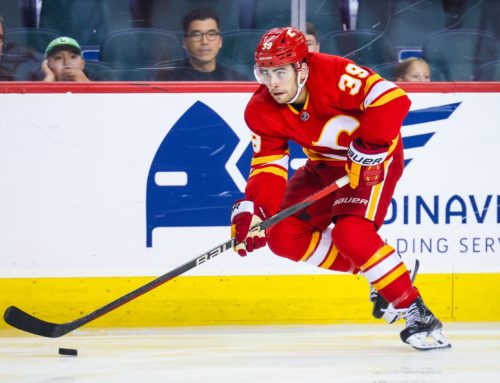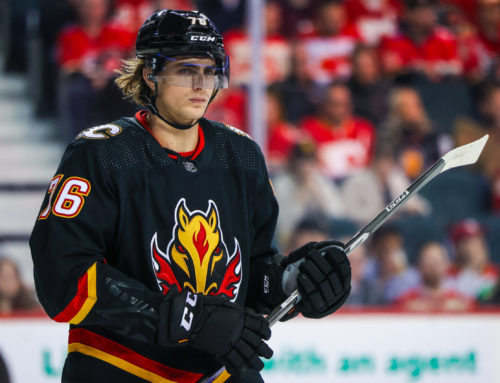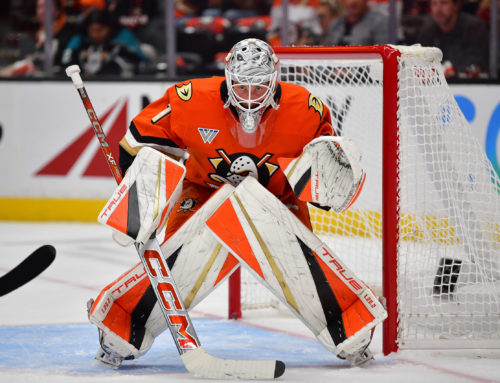
A big part of the early season is figuring out players who could breakout before they actually do. A lot of ink is spilled in the lead up to drafts about sleepers, which players will get a chance to play up in the lineup, and which rookies have a chance to win the Calder. But very little is said about players who can break out peripherally. But in categories leagues, those stats: penalty minutes, hits, and blocks, are worth just as much as the offensive categories if you can win them.
The formula for predicting peripheral breakouts is fairly similar to trying to pick up on possible offensive sleepers. You’re looking for either talent or opportunity, and preferably both. In fantasy sports, opportunity is king. In hockey terms, that means you’re looking for players who will have a huge jump in time on ice, and will be able to maintain their scoring / peripheral rates in their new role.
Over the past few years, recognizing early-season trends has been key for picking up on players who make a huge impact in bangers leagues. Darnell Nurse went largely undrafted a few years ago, but his hits and penalty minute rates showed he was due for a huge breakout in bangers leagues. He’s now become one of the most dependable players in these formats. This year I have my eye on two defenders through the early season, who have a chance to be incredibly valuable in new roles: Erik Cernak and Neal Pionk.
Pionk
Neal Pionk is a highly controversial figure in hockey circles. To fantasy hockey players, he represents a very decent floor-player who puts up great peripherals, and can produce on the power play. Those who watched the Rangers closely in 2018-19 saw a defenseman who was way out of his depth at even strength, and for some reason kept being put in a position to fail, by being placed on the top pair with veteran Marc Staal.
What made Pionk a great own in fantasy circles last year was his production on the power play, matched with his strong peripheral category coverage. Over the first half of the season, Pionk averaged over 22:30 per night in ice time. Over the first 39 games, he put up a per-82 game pace of 41 points, 26 power-play points, 154 shots, 166 hits, and 141 blocks. While none of the three latter categories are mind-blowing numbers, they’re all useful contributions. The only player who eclipsed those totals in the all three categories last year was Nurse.
Midway through 2018-19, David Quinn seemed to have enough of Pionk. His ice time fell by three minutes per night, and by game 82 he had lost nearly all of the power-play time that gave him his offensive upside. In losing all that ice time, his peripheral category production dipped as well.
A trade to Winnipeg in the offseason may be just what Pionk needed to rebuild his fantasy value. He doesn’t look any better defensively, and yet, he’s averaged over 25:00 a night through his first two games. If you follow the NHL long enough, you come to realize head coaches aren’t always necessarily rational with their deployment. While 25+ minutes isn’t likely sustainable, if Pionk can maintain 21+ minutes he should be able to put up very strong back-end numbers.
Had Pionk not been part of the trade for Jacob Trouba, he’d probably be rotting behind Trouba, Adam Fox, and Tony DeAngelo on the depth chart, waiting for power-play time. But in Winnipeg? The Trouba trade, Tyler Myers leaving in free agency, and the sudden disappearance of Dustin Byfuglien has opened a lot of opportunities for Pionk on a decimated Jets’ back end.
Pionk actually had surprising levels of success on the Rangers last year. By Evolving-Hockey’s Games Above Replacement stat, he ranked 11th in PPO (power-play offense), which looks at powerplay prowess relative to replacement level, Pionk ranked right between Brent Burns and Morgan Rielly. He also produced 7.14 points for every 60 minutes of powerplay time. That was good enough for fifth in the league, ahead of Victor Hedman, John Klingberg, Burns, John Carlson, and Rielly.
Say what you will about Josh Morrissey’s talent, he certainly wasn’t Plan A for the top power-play unit when the Jets hit training camp. Pionk may represent a huge upgrade over Morrissey in that spot: by points/60 and Evolving Hockey’s PPO, Pionk ranks much higher than his teammate.
Advice: If you’re in a bangers league, Pionk should already be in your watch list. If you have a hole in your roster and you’re looking for peripherals he may be the best upside play available. If he winds up getting a shot on Power Play 1, there’s a chance he can wrestle the reins away from Josh Morrissey, at which point he becomes a must-own. If Byfuglien comes back, the upside fizzles out pretty quickly.
Cernak
Cernak played in only 58 regular season games last year, but was a solid play in deeper banger leagues. While he only paced for 23 points over a full campaign, he registered 58 penalty minutes, 107 shots on goal, 198 hits, and 79 blocks. Definitely not a superstar, and his ownership rates in Yahoo seem to reflect that: Cernak remains owned in fewer than 20 percent of fantasy leagues as of this weekend.
But is there a reason to expect a positive uptick in Cernak’s production? One that takes him from a serviceable depth option to a must-own d-man in banger leagues?
Last year, Cernak had a per-game average time on ice of 19:15. He was comfortably fourth on the Bolts’ defensive depth chart. Since then, Anton Stralman left, freeing up a spot next to Ryan McDonagh at even strength and on the penalty kill.
While Victor Hedman is the king in Tampa Bay when it comes to PP time, Ryan McDonagh led the team in even strength and penalty kill minutes last year, and appears poised to continue that trend in 2019-20. If Cernak holds on to this deployment, it’s easy to visualize a route for him to play an extra two minutes per night this year.
So what would it look like if we forecasted Cernak’s last year’s per 82-game rate to match this rise in deployment?
Season ATOI G A P PIMS SOG Hits Blocks
|
2019-20 |
21:15 |
8 |
17 |
25 |
91 |
167 |
309 |
123 |
Those look like prime-era Radko Gudas numbers. If your league counts hits, penalty minutes, and blocks, someone should have Erik Cernak on their roster.
Advice: While it’s tough to drop an established PP1 QB, Cernak deserves to be on someone’s roster in every league. If you have a roster spot to see what his upside can be, I think it’s time to take the flyer on him and see how this deployment shakes out. He could wind up being a savvy waiver add that raises your team’s floor as the season really starts to take off.





 EDM
EDM FLA
FLA CHI
CHI ANA
ANA CGY
CGY MIN
MIN
